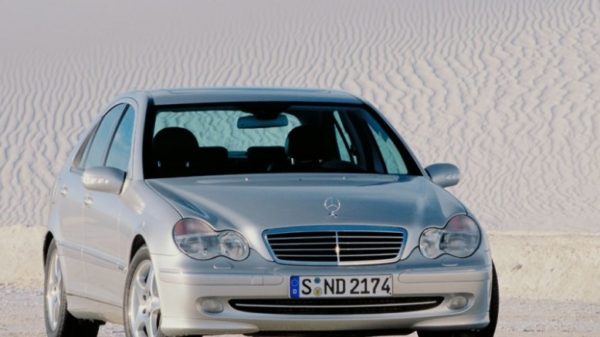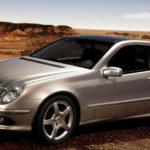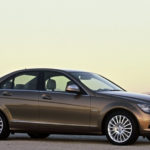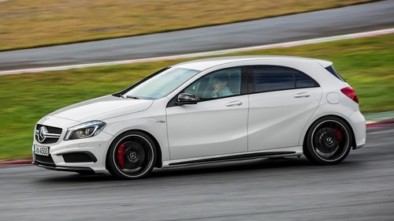Mercedes C W203 2000 - 2007 - The most common problems and breakdowns

Mercedes C Class
What are the most common problems and failures of the Mercedes C Class and how to solve them?
Mercedes C class - ALL MODELS
PROBLEM - Punching from the front suspension when driving on bad roads or over lying cops.
CAUSE - Insufficient distance between the upper front shock absorber bracket and the upper support plate. Worn or damaged inner suspension of the lower torsion arm of the front suspension. Worn balls of the lower torsion arm of the front suspension.
REPAIR - Check that the distance between the upper front shock absorber bracket and the upper support plate is 2 mm. Replace the upper support plate if necessary. Inspect for worn or damaged front suspension lower torsion arm bracket and replace if necessary. Check that the front suspension lower torsion arm ball is worn and replace if necessary.
Mercedes C class - ALL MODELS
PROBLEM - The airbag control indicator illuminates.
CAUSE - High resistance at the front / rear side airbag assembly connections.
REPAIR - Locate the front side airbag electrical wiring connections behind the left / right trim in the footwell. Locate the rear side airbag electrical wiring connections under the left / right rear door sill trim. Remove the sockets and permanently connect the wires using the thermal connectors.
Mercedes C class - ALL MODELS
PROBLEM - Control indicator illuminates ABS/ ESP.
CAUSE - Corrosion at the control module multi-connector connectors ABS/ ESP 18, 19 and 20.
REPAIR - Clean all connectors. Repair the control module multi-connector connectors ABS/ ESP 18, 19 and 20 using repair equipment and solder joint. The multi-connector and connectors must be dry before connecting them. After repair, check that the brake pressure sensor electrical installation is correct. Maximum resistance: 0,5 ohms.
Mercedes C class - ALL MODELS
PROBLEM - Squeaking / friction from the boot lid hinge.
CAUSE - Insufficient lubrication of the boot lid brake mechanism.
REPAIR - Lubricate the boot lid brake mechanism.
Mercedes C class - ALL MODELS
PROBLEM - Xenon headlights do not work.
CAUSE - Moisture / corrosion at the xenon headlight connector.
REPAIR - Check the xenon headlight connector for corrosion. Replace components if necessary.
Mercedes C class - ALL MODELS
PROBLEM - The engine does not start, the front wipers do not work. 'Brake lamp fault' is displayed on the instrument panel.
CAUSE - Relay fault in fuse box / relay board in engine compartment.
REPAIR - Install the new relays to the positions in the fuse box / relay board in the engine compartment.
Mercedes C class - MODELS WITH ENGINE CODE 271
PROBLEM - Noise from the engine. Loud noise from the auxiliary drive belt.
CAUSE - Faulty alternator pulley.
REPAIR - Remove the auxiliary drive belt. Check that the alternator pulley works without problems: Turn the alternator pulley clockwise by hand. Activate the alternator pulley clutch. Turn the alternator pulley by hand counterclockwise. Deactivate the alternator pulley coupling. Install a new alternator pulley if necessary. Use a special tool.
Mercedes C class - ALL MODELS
PROBLEM - The engine is difficult to start and shut down. Possible stored error codes. Loss of compression on one cylinder.
CAUSE - Exhaust blown valves due to defective cylinder head.
REPAIR - Perform a compression or leak test before removing the cylinder head. Install the modified cylinder head.
Mercedes C class - PETROL MODELS
PROBLEM - High idle speed: 1000 rpm. Whistling from the body space of the valve. All air pipes are installed correctly and do not leak.
CAUSE - Porous valve body.
REPAIR - Remove the valve body and inspect. Replace the valve body if necessary.
Mercedes C-Class - MODELS WITH STANDARD SUSPENSION SINCE 2003
PROBLEM - Tapping from the front suspension on uneven surfaces.
CAUSE - Wear of the connecting rod balance bar.
REPAIR - Install new balance bar tie rods.
Mercedes C class - MODELS WITH MANUAL GEARBOX
PROBLEM - Difficult to shift from first to second gear when it is cold.
CAUSE - Too much transmission oil.
REPAIR - Reduce the amount of oil by 300 ml. Drain and fill the transmission with a reduced amount of oil.
Mercedes C class - MODELS WITH TRANSMISSION CODE 716
PROBLEM - Difficult to select 1st gear and reverse gear. Difficult shifting from 1st to 2nd gear.
CAUSE - The speed selector cable is not set up properly. Central clutch plate blocked on transmission input shaft.
REPAIR - Check and adjust the speed selector cable. If the speed selector cable setting is correct: Remove the transmission assembly. Clean and lubricate the transmission input shaft grooves.
Mercedes C class - MODELS WITH CODE 272/273
PROBLEM - Incorrect sound from the auxiliary drive belt.
CAUSE - Air conditioning compressor pulley error.
REPAIR - Remove the auxiliary drive belt. Install a shorter auxiliary drive belt that bridges the air conditioning compressor. Start the engine. If no more noise is heard, stop the engine. Install a new A / C compressor pulley. Install the original auxiliary drive belt.
Mercedes C class - MODELS WITH CODE 272/273
PROBLEM - Engine Malfunction Indicator Lamp (MIL) illuminates.
CAUSE - Incorrect valve phase adjustment due to balance shaft pulley wear.
REPAIR - Check pulleys and timing chain for wear. Install a new balance shaft and counterweight if necessary. Install a new timing chain tensioner. Install a new engine oil pump. Replace engine oil and filter. Make a test drive for at least 20 minutes using all speeds and accelerating several times from 1500 to 3500 / min. Replace the engine oil and filter. Install new camshaft position (CMP) actuators.
Mercedes C class - MODELS WITH CODE 272/273
PROBLEM - Engine Malfunction Indicator Lamp (MIL) illuminates.
CAUSE - Camshaft Position (CMP) actuator (s) defective.
REPAIR - Install new camshaft position (CMP) actuator (s).
Mercedes C class - MODELS WITH CODE 272/273
PROBLEM - Camshaft Position Actuator (CMP) oil leak.
CAUSE - Faulty camshaft position (CMP) actuator oil seal.
REPAIR - Install a new oil seal to the camshaft position (CMP) actuator.
Mercedes C class - MODELS WITH CODE 272/273
PROBLEM - Whining / grinding sound from the front of the engine.
CAUSE - Auxiliary drive belt guide pulley defective.
REPAIR - Remove the auxiliary drive belt. Start the engine. If no more noise is heard, stop the engine. Install a new auxiliary drive belt guide pulley.
Mercedes C class - MODELS WITH ENGINE CODE 642
PROBLEM - Engine Malfunction Indicator Lamp (MIL) illuminates. The engine runs in forced mode. Blown fuse (s) of the engine control system.
CAUSE - Short circuit on the intake manifold air control actuator due to oil contamination from the turbocharger (TC) pipe.
REPAIR - Install a new intake manifold air control actuator. Clean the oil deposits from the turbocharger pipe (TC). The turbocharger pipe (TC) must be attached. Replace blown engine control fuse (s). Clear the error codes from the engine computer memory (ECM).
Mercedes C class - MODELS WITH DIESEL ENGINES
PROBLEM - Loose auxiliary drive belt.
CAUSE - Alternator pulley clutch failure.
REPAIR - Replace the alternator pulley coupling.
Mercedes C class - MODELS WITH ENGINE CODE 642 AND GEARBOX 722.9
PROBLEM - Difficult shifting, at lower load, from 1st to 2nd and 2nd to 3rd gear, or from 2nd to 1st and from 3rd to 2nd gear.
CAUSE - Software error engine computer (ECM).
REPAIR - Test electronics and mechanics components (as needed) to eliminate other possible causes. If no error is found: Program again engine computer (ECM) with upgraded software. Reprogram the TCM with the upgraded software.
Mercedes C class - MODELS WITH GEAR CODE 722.9
PROBLEM - Delayed reverse gear. Difficulty activating the transmission when reverse gear is selected.
CAUSE - Transmission Control Module (TCM) software error.
REPAIR - Test electronics and mechanics components (as needed) to eliminate other possible causes. If no error is found: Reprogram the transmission control module (TCM) with the upgraded software. Adjust the TCM in a few kilometers of driving to different road conditions.
Retrieved from: autoportal.hr
Recommendation of similar texts:

Hi there, I am Mladen and I am an auto enthusiast. I started this blog years ago to help like minded people share information about latest cars, car servicing ideas, used car info, exotic cars, and auto technology. You will find helpful articles and videos on a wide variety of cars - Audi, Mercedes, Toyota, Porsche, Volvo, BMW and much more. Ping us if you have anything cool to share on latest cars or on how to make older cars more efficient, or just want to say hi!








Mercedes c 220 2003 Whatever the engine will not start when the engine is hot, when it is cold and sometimes it wants to start the correct pressure regulator, the correct crankshaft sensor, the correct camshaft sensor indicates when the engine is running and will not start without sufficient fuel pressure.
Dude and I have this problem when it's hot it won't turn on cold it burns normally on half the key.
Can you tell me if and how you solved that problem?
Did he solve this problem what is the catch
https://www.google.com/search?q=y94/3+mercedes&prmd=imvn&sxsrf=ALeKk02nvJ_lAn6ooxBzVKitOnHOjIN37Q:1603766886570&source=lnms&tbm=isch&sa=X&ved=2ahUKEwit1s2c4dPsAhWFDewKHWhBD_oQ_AUoAXoECAMQAQ&biw=360&bih=592#imgrc=rw2jbDCg5BjZ2M
Have you solved the ignition problem with the Mercedes, I have the same problem
Can you help me solve the problem when it is a mere heater in the head of a c200 cdi Mercedes? How to get out of the engine? Thank you
Mercedes c clasa 220 2002g diesel
It pulls my electricity out of the battery for almost 17 am.
W203 c200 2003 year.
When it is warm, it will not work, when it is cold, it will work great on half the key, when it warms up a little, it will not work, or it rarely happens that the vergla works for a long time and works.
Can help what can be.
I also had that problem and replaced all the nozzles and also in the end replaced some sensor on the head and it fires like a bullet and hot and cold
Did you solve the problem with starting the Mercedes since I have the same problem
It turns on the EPC lamp and it works normally when I turn it off and turn it on, I don't know what it is
C270 I give the contact everything is ok the heater lamp is shining I start the engine I hear a squeak but they don't spin like on the first tooth only, it doesn't give any damage everything is ok,
C200 petrol jumps my revs from 1000 to 2000. When I drive the accelerator pedal unresponsive ???
The gas valve is not ok, there is oil in the part where the electronics and the potentioner are. Disassemble and clean and work.
The dashboard on the 180 c2002 petrol shows no signs of life. The car starts without a problem
Dear, Mercedes w203 c220 110kw 2005 year, idle gas jumps in place for 50-100 rpm from normal. Fuel pressure regulator and sensor are OK, diagnostics do not show any error. Can anyone help me with this problem? Thankful in advance. 🙂 Greetings!